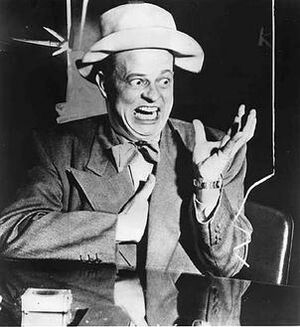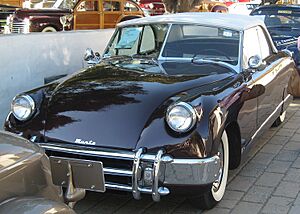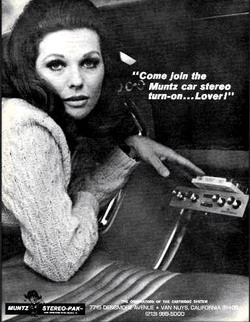Madman Muntz facts for kids
Quick facts for kids
Madman Muntz
|
|
|---|---|

Muntz in one of his many television advertisement performances
|
|
| Born |
Earl William Muntz
January 3, 1914 Elgin, Illinois, US
|
| Died | June 21, 1987 (aged 73) |
| Occupation |
|
Earl William "Madman" Muntz (born January 3, 1914 – died June 21, 1987) was an American businessman and engineer. He was famous for selling cars and electronics in the United States. Muntz was a pioneer in TV commercials. He used a funny "Madman" character to get attention. This character wore unusual costumes and made outrageous claims.
Muntz also helped create car stereos. He invented the Muntz Stereo-Pak, also called the 4-track cartridge. This was an early version of the 8-track cartridge. He also came up with a way to simplify electronics. This became known as "Muntzing". He made the first black-and-white TVs that cost less than $100. He also created one of the first working widescreen projection TVs. Many people say he invented the short word "TV" for television. Even though he dropped out of high school, Muntz made a lot of money selling cars, TVs, and car stereos.
Muntz was friends with many famous people. These included singer Rudy Vallee and comedian Jerry Colonna. He was also friends with TV host Dick Clark and cowboy actor Gene Autry.
Contents
Early Career and Big Ideas (1922–1953)
Earl Muntz loved electronics from a young age. He built his first radio when he was 8 years old. At 14, he built another radio for his parents' car. During the Great Depression, when he was 15, he left high school. He went to work in his parents' hardware store.
Selling Cars and Becoming a "Madman"
In 1934, Muntz opened his first used car lot in Elgin, Illinois. He was only 20 years old. His mother had to sign the sales papers because he was too young. While on vacation in California, Muntz saw that used cars sold for much more money there. So, in 1940, he moved to California. He opened a used car lot in Glendale.
Muntz bought 13 brand-new cars that were made for customers in Asia. But they couldn't be sent because of World War II. One car was a special Lincoln made for Chiang Kai-shek. Local newspapers wrote stories about these unusual cars. Muntz sold all of them in two weeks.
Muntz didn't want to be a boring car salesman. He decided to create a "Madman" character to get attention. His wild billboards and funny TV and radio ads made him famous. In his car commercials, he would say that if a car didn't sell that day, he would smash it with a sledgehammer. Another famous ad said, "I buy 'em retail and sell 'em wholesale ... it's more fun that way!" His ads were so popular that comedians like Bob Hope and Jack Benny told "Madman" Muntz jokes.
Muntz's car lots became popular places for tourists to visit. A 1946 survey said they were the seventh most popular tourist spot in Southern California.
The Muntz Jet Car
In 1951, Muntz bought the rights to make a sports car from designer Frank Kurtis. Muntz renamed the car the "Muntz Jet". He made the car longer to fit four people. He also changed the engine to a more powerful Cadillac V8. Later, he used a less expensive Lincoln V8 engine.
The Muntz Jet was featured on the cover of Popular Science magazine. It had a unique design with aluminum body panels. The paint colors were exciting, like "Mars Red" and "Stratosphere Blue". Inside, it even had a small bar in the back armrests!
The Jet could go very fast for its time, up to 125 miles per hour (201 km/h). It could go from 0 to 50 mph (0 to 80 km/h) in just 6 seconds. Famous owners included the head of CBS, Frank Stanton, and actor Mickey Rooney.
Making the Jet was expensive. Muntz lost about $1,000 on each car. In 1954, after selling about 400 cars, he closed the company. Today, Muntz Jets are valuable collector cars. They are seen as early versions of cars like the Chevrolet Corvette.
Muntz TV: Making TVs Simpler
Muntz started selling television sets in 1947. He played the "madman" in his TV ads, but he was also a smart businessman. He taught himself about electronics. He took apart TVs from other companies like Philco and RCA. He figured out how to use fewer parts to make them work. This idea became known as "Muntzing".
In the 1940s and 1950s, most TVs were very complex. They had many vacuum tubes and other heavy parts. This made them very expensive. For example, a TV with a 12-inch screen cost $445 in 1939. By 1954, only about half of U.S. homes had a TV.
Muntz created a TV that used only 17 tubes. He would often carry wire cutters. If he thought an engineer was using too many parts, he would snip them out. He would stop when the picture or sound stopped working. Then he would tell the engineer, "Well, I guess you have to put that last part back in."
His company, Muntz TV, Inc., sold these simpler TVs. They were the first black and white TVs in the U.S. to cost less than $100. Muntz was also the first to measure TV screens from corner to corner. His TVs sold well because they were cheaper and reliable. They worked best in cities where TV signals were strong. Muntz knew his customers were mostly city people who didn't have a lot of money. Many city apartments didn't allow outside antennas. So, Muntz added a built-in antenna to his TVs. In 1952, Muntz TV Inc. made $49.9 million.
Muntz continued his "Madman" ads. In one TV commercial, he wore red long underwear and a Napoleon hat. He promoted his new 14-inch TVs by saying, "I wanna give 'em away, but Mrs. Muntz won't let me. She's crazy!"
Some people say Muntz invented the abbreviation "TV". He used skywriting for ads. But he noticed the letters would blur before the pilot could finish "Muntz Televisions". So, he came up with "TV". However, the term "TV" was already used in some TV station names, like WCBS-TV. Muntz even named his daughter "Tee Vee," though she usually went by "Teena."
Audio and Video Innovations (1954–1985)
Despite his early success, Muntz TV went out of business in 1959. But Muntz kept selling cars and other electronics.
The 4-Track Cartridge
Muntz wanted to combine cars and stereos. So, he invented the Muntz Stereo-Pak 4-track tape cartridge. This was a direct ancestor of the 8-track cartridge. Before Muntz, the only way to play recorded music in a car was with record players. But these would skip when the car hit bumps.
Muntz designed a stereo tape player for cars called the Autostereo. It was made cheaply in Japan. The Autostereo could play a whole album without changing tracks. It didn't skip like record players. It also had very few buttons so drivers could focus on the road. Customers liked having more control over their music.
By 1962, Muntz's audio products were making a lot of money. He started his own company to make pre-recorded Stereo-Pak cartridges. He got licenses from all the major record labels. He released hundreds of different tapes in the 1960s.
The Autostereo player cost about $129 in 1963. It was popular with rich and famous people in Beverly Hills. Frank Sinatra, Dean Martin, and Jerry Lewis all had them in their cars. Jerry Lewis even recorded his scripts on Stereo-Pak cartridges to learn his lines while driving.
Muntz tried to make his players and cartridges seem cool and modern. His ads often showed the player in a sports car with a young, attractive model. His stores in California had attractive young women working there.
In 1963, Bill Lear started selling the Stereo-Pak. He wanted to put them in his Learjet planes. But he decided to make his own version, which became the Stereo 8 system. By 1970, the 4-track system lost popularity because of the Stereo 8. The 8-track was cheaper to make. Even though the 4-track had better sound, the Stereo 8 became the main car stereo format. Ford Motor Company started putting 8-track players in their cars in 1965.
Muntz later said that returned tapes were a big problem for his Stereo-Pak business. When a popular album became less popular, stores would return unsold tapes. This huge cost made his business unprofitable.
Home Video Systems
In the late 1970s, Muntz got into the home video market. He took a 15-inch Sony color TV. He added a special lens and mirror to project the image onto a bigger screen. He put these early units in large wooden cabinets. This made it one of the first successful widescreen projection TVs for homes.
These TVs were built in Muntz's headquarters in Van Nuys, California. He sold them directly to customers. By 1977, his projection TV business was worth millions of dollars. Muntz quickly started selling Sony's Betamax and JVC's VHS video recorders. He set up a showroom to show how people could have a "theater experience at home."
In 1979, Muntz started selling blank tapes and VCRs at a very low price. This was to get customers into his showroom. Once there, he would try to sell them his projection TV systems. His success continued into the early 1980s. However, he invested a lot in a video system called the Technicolor Compact Video Cassette (CVC). This system failed, and Muntz's store closed soon after.
Later Years and Lasting Impact
Before he died from lung cancer in 1987, Muntz focused on selling cellular phones and satellite dishes. He also had a company that rented motorhomes. In 1985, he was the first seller to offer a Hitachi cellular phone for less than $1,000. Just two years before, most cell phones cost about $3,000. When he died, he was the top seller of cellular phones in Los Angeles. In his last years, Muntz drove a special Lincoln Continental with a TV in the dashboard. He said it helped him "drive better."
After his death, his children, James and Tee, continued to run two Muntz stores. James used his father's advertising tricks to create flashy ads.
Muntz's Legacy
The "Madman" advertising style that Muntz started was copied by other sellers. These included car salesman Cal Worthington and electronics chain Crazy Eddie. In Crazy Eddie TV commercials, a radio personality would jump around and talk very fast. He always ended with, "Crazy Eddie: Our prices are insaaaaaane!"
Muntz was so famous that he was mentioned in books. These included the children's book The Neddiad by Daniel Manus Pinkwater.
A film called Madman Muntz: American Maverick was shown at film festivals in 2007. It tells the story of Muntz's life and his colorful career. It includes interviews with people who knew him and home videos from his children.
In 2001, Madman Muntz was honored by being put into the Consumer Electronics Hall of Fame.
See also




